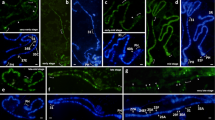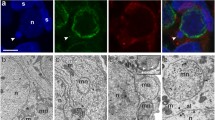Summary
Dramatic changes in the DNA composition of post-mitotic versus mitotic and germ line nuclei occur during development in different organisms. Drosophila nasutoides possesses n=4 chromosomes which were quantified with a microphotometer in females. The diploid (2 C) DNA content was 0.79 pg or 7.7×108 nucleotide pairs, calculated from brain metaphases and calibrated with hen erythrocyte nuclei. The individual elements comprised X=9%, 2=16%, 3=13%, and 4=62% of the total complement. In polytene nuclei of larval salivary glands which had undergone 11 endoreplication cycles, chromosome 4 contained only 1.55% of total Feulgen DNA. Thus, in contrast with other Drosophila genomes, where under-replicating material is dispersed to all elements, a huge quantity of non-endoreplicating DNA is restricted to a single chromosome. This permits accurate determination of the timing of under-replication in the single cell. The data presented here suggest that the schedule is tissue-specific. Larval hind gut and salivary duct nuclei begin under-replication during the first endocycle, whereas adult and larval salivary glands mainly begin during the second cycle. In Malpighian tubules the onset of selective DNA syntheses occurs during either the first or the second endocycle.
Similar content being viewed by others
References
Barlow PW (1978) Endopolyploidy: towards an understanding of its biological significance. Acta Biotheoret 27:1–18
Barr HJ, Ellison JR (1972) Ectopic pairing of chromosome regions containing chemically similar DNA. Chromosoma 39:53–61
Beckingham K (1982) Insect rDNA. In: Busch H, Rothblum L (eds) The cell nucleus, vol 10, part A. Academic Press, New York, pp 205–269
Beckingham K, Rubacha A (1984) Different chromatin states of the intron− and type 1 intron+ rRNA genes of Calliphora erythrocephala. Chromosoma 90:311–316
Beermann W (1962) Riesenchromosomen. Protoplasmatologia vol 6 D. Springer, Wien
Bennett MD (1972) Nuclear DNA content and minimum generation time in herbaceous plants. Proc R Soc B (Lond) 181:109–135
Berendes HD, Ashburner M (1978) The salivary glands. In: Ashburner M, Wright TRF (eds) The genetics and biology of Drosophila, vol 2b. Academic Press, New York, pp 453–498
Berendes HD, Keyl H-G (1967) Distribution of DNA in heterochromatin and euchromatin of polytene nuclei if Drosophila hydei. Genetics 57:1–13
Bier K (1960) Der Karyotyp von Calliphora erythrocephala Meigen unter besonderer Berücksichtigung der Nährzellkernchromosomen im gebündelten und gepaarten Zustand. Chromosoma 11:335–364
Blackburn EH (1985) Artificial chromosomes in yeast. Trends Genet 1:8–12
Bolshakov VN, Zharkikh AA, Zhimulev IF (1985) Intercalary heterochromatin in Drosophila. II. Heterochromatic features in relation to local DNA content along the polytene chromosomes of Drosophila melanogaster. Chromosoma 92:200–208
Bonner WM, Laskey RA (1974) A film detection method for tritium-labelled proteins and nucleic acids in polyacrylamide gels. Eur J Biochem 46:83–88
Brodsky VY, Uryvaeva IV (1985) Genome multiplication in growth and development. Biology of polyploid and polytene cells. University Press, Cambridge
Brower DL, Smith RJ, Wilcox M (1980) A monoclonal antibody specific for diploid epithelial cells in Drosophila. Nature 285:403–405
Callan HG (1972) Replication of DNA in the chromosomes of eukaryotes. Proc R Soc B (Lond) 181:19–41
Cordeiro M, Wheeler L, Lee CS, Kastritsis CD, Richardson RH (1975) Heterochromatic chromosomes and satellite DNAs of Drosophila nasutoides. Chromosoma 51:65–73
Cordeiro-Stone M, Lee CS (1976) Studies on the satellite DNAs of Drosophila nasutoides: their buoyant densities, melting temperatures, reassociation rates and localizations in polytene chromosomes. J Mol Biol 104:1–24
Cowell JK, Hartmann-Goldstein IJ (1980) Contrasting response of euchromatin and heterochromatin to translocation in polytene chromosomes of Drosophila melanogster. Chromosoma 79:329–340
Durie BGM, Salmon SE (1975) High speed scintillation autoradiography. Science 190:1093–1095
Endow SA, Gall JG (1975) Differential replication of satellite DNA in polyploid tissues of Drosophila virilis. Chromosoma 50:175–192
Franz G, Kunz W, Grimm C (1983) Determination of the region of rDNA involved in polytenization in salivary glands of Drosophila hydei. Mol Gen Genet 191:74–80
Gall JG, Cohen EH, Polan ML (1971) Repetitive DNA sequences in Drosophila. Chromosoma 33:319–344
Gatti M, Pimpinelli S (1983) Cytological and genetic analysis of the Y chromosome of Drosophila melanogaster. I. Organization of the fertility factors. Chromosoma 88:349–373
Hägele K, Ranganath HA (1982) The chromosomes of two Drosophila races: D. nasuta nasuta and D. nasuta albomicana. II. Differences between their microchromosomes. Chromosoma 85:215–220
Hammond MP, Laird CD (1985) Control of DNA replication and spatial distribution of defined DNA sequences in salivary gland cells of Drosophila melanogaster. Chromosoma 91:279–286
Hartenstein V, Campos-Ortega JA (1984) Early neurogenesis in wild-type Drosophila melanogaster. Wilhelm Roux's Arch 193:308–325
Heitz E (1934) Über α- und β-Heterochromatin sowie Konstanz und Bau der Chromomeren bei Drosophila. Biol Zbl 54:588–609
Hilliker AJ, Appels R, Schalet A (1980) The genetic analysis of D. melanogaster heterochromatin. Cell 21:607–619
Hotta Y, Tabata S, Stern H (1984) Replication and nicking of zygotene DNA sequences. Control by a meiosis-specific protein. Chromosoma 90:243–253
Jacob F, Brenner S (1963) Sur la régulation de la synthèse du DNA chez les bactéries: l'hypothèse du réplicon. C R Hebd Séanc Acad Sci (Paris) 256:298–300
John B, Miklos GLG (1979) Functional aspects of satellite DNA and heterochromatin. Int Rev Cyt 58:1–114
Kalisch WE, Whitmore T, Schwitalla G (1985) Electron microscopic map of surface-spread polytene chromosomes in Drosophila hydei. Chromosoma 92:265–272
Lakhotia SC (1984) Replication in Drosophila chromosomes. XII. Reconfirmation of underreplication of heterochromatin in polytene nuclei by cytofluorometry. Chromosoma 89:63–67
Laskey R, Mechali M (1982) Vive le réplicon! Nature 300:579–580
Lee CS (1974) DNA synthesis in larval brains of Drosophila nasutoides. Biochem Genetics 12:475–483
Lee CS (1981) Restriction enzyme analysis of a highly diverged satellite DNA from Drosophila nasutoides. Chromosoma 83:367–379
Lee CS, Collins L (1977) Q- and C-bands in the metaphase chromosomes of Drosophila nasutoides. Chromosoma 61:57–60
Lifschytz E (1983) Sequence replication and banding organization in the polytene chromosomes of Drosophila melanogaster. J Mol Biol 164:17–34
Mahowald AP, Caulton JH, Edwards MK, Floyd AD (1979) Loss of centrioles and polyploidization in follicle cells of Drosophila melanogaster. Exp Cell Res 118:404–410
Nagl W (1978) Endopolyploidy and polyteny in differentiation and evolution. North-Holland Publishing Company, Amsterdam
Okada T (1964) Drosophilidae (Diptera) of southeast Asia collected by the Thai-Japanese biological expedition 1961–62. In: Kira T, Umesao T (eds) Nature and life in southeast Asia, vol 3. Fauna and Flora Res Soc, Kyoto, pp 439–466
Pearson MJ (1974) Polyteny and the functional significance of the polytenic cell cycle. J Cell Sci 15:457–479
Pelling C (1966) A replicative and synthetic chromosomal unit — the modern concept of the chromomere. Proc R Soc B (Lond) 164:279–289
Rasch EM, Barr HJ, Rasch RW (1971) The DNA content of sperm of Drosophila melanogaster. Chromosoma 33:1–18
Ribbert D (1979) Chromomeres and puffing in experimentally induced polytene chromosomes of Calliphora erythrocephala. Chromosoma 74:269–298
Ringertz NR, Bolund L (1974) The nucleus during avian erythroid differentiation. In: Busch H (ed) The cell nucleus, vol 3. Academic Press, New York, pp 417–446
Ringertz NR, Nyman U, Bergman M (1985) DNA replication and H5 histone exchange during reactivation of chick erythrocyte nuclei in heterokaryons. Chromosoma 91:391–396
Rudkin GT (1965) The structure and function of heterochromatin. In: Geerts SJ (ed) Genetic today, vol 2. Proc XI Int Congr Genet. Pergamon Press, Oxford, pp 359–374
Sager R, Kitchin R (1975) Selective silencing of eukaryotic DNA. Science 189:426–433
Sawicki W, Ostrowski K, Platkowska E (1977) High-speed autoradiography of 3H-thymidine-labelled nuclei. Histochemistry 52:341–347
Sokoloff St, Zacharias H (1977) Functional significance of changes in the shape of the polytene X chromosome in Phryne. Chromosoma 63:359–384
Spear BB, Gall JG (1973) Independent control of ribosomal gene replication in polytene chromosomes of Drosophila melanogaster. Proc Natl Acad Sci (USA) 70:1359–1363
Spierer A, Spierer P (1984) Similar level of polyteny in bands and interbands of Drosophila giant chromosomes. Nature 307:176–178
Spradling AC, Rubin GM (1981) Drosophila genome organization: conserved and dynamic aspects. Ann Rev Genet 15:219–264
Steinbrecher RA (1985) Mikrophotometrische Untersuchung der DNA-Gehalte mitotischer und polytäner Zellkerne bei der Taufliege Drosophila virilis. Diplomarbeit, Universität Kiel
Van de Flierdt K (1975) No multistrandedness in mitotic chromosomes of Drosophila melanogaster. Chromosoma 50:431–434
Wheeler LL, Altenburg LC (1977) Hoechst 33258 banding of Drosophila nasutoides metaphase chromosomes. Chromosoma 62:351–360
Wheeler LL, Arrighi F, Cordeiro-Stone M, Lee CS (1978) Localization of Drosophila nasutoides satellite DNAs in metaphase chromosomes. Chromosoma 70:41–50
Wheeler LL, Capps AS, Wilson FD (1973) The heterochromatic chromosome of D. nasutoides. Drosophila Inf Serv 50:68
Wilson FD, Wheeler MR, Harget M, Kambysellis M (1969) Cytogenetic relations in the Drosophila nasuta subgroup of the immigrons group of species. University Texas Publ 6918:207–253
Yamamoto M, Miklos GLG (1978) Genetic studies on heterochromatin in Drosophila melanogaster and their implications for the functions of satellite DNA. Chromosoma 66:71–98
Zacharias H (1977) Unterreplikation bei Prodiamesa olivacea (Chironomidae). Haag und Herchen, Frankfurt/Main
Zacharias H (1981) Sex-linked difference in DNA content of a polytene chromosome in Prodiamesa (Chironomidae). Chromosoma 82:657–672
Zacharias H (1984) Allocyclic behaviour and underreplication of the nucleolus chromosome in Pseudodiamesa (Chironomidae). Chromosoma 89:263–273
Zhimulev IF, Semeshin VF, Kulichkow VA, Belyaeva ES (1982) Intercalary heterochromatin in Drosophila. I. Localization and general characteristics. Chromosoma 87:197–228
Author information
Authors and Affiliations
Rights and permissions
About this article
Cite this article
Zacharias, H. Tissue-specific schedule of selective replication in Drosophila nasutoides . Roux's Arch Dev Biol 195, 378–388 (1986). https://doi.org/10.1007/BF00402871
Received:
Accepted:
Issue Date:
DOI: https://doi.org/10.1007/BF00402871




